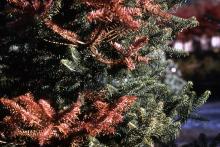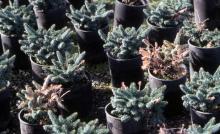See:
Fir, True (Abies spp.) - Root Rot, Phytophthora
Cause Several species of Phytophthora, including P. citricola and P. citrophthora. This disease occurs is favored when trees are irrigated from overhead. Whether the fungus-like microorganism enters the main trunk or is limited only to branches varies with species. Phytophthora shoot blight has been found on noble (Abies procera), alpine (A. lasiocarpa), Algerian (A. numidica), and balsam (A. balsemea) fir in Oregon and has been reported on red (A. magnifica) and white (A. concolor) fir in California. Both Christmas trees and container-grown trees can develop the disease.
Symptoms Branch dieback usually is first noticed when needles at branch tips turn red. Wood under the bark is medium brown with a distinct margin where dead (necrotic) tissue adjoins healthy tissue. Often, necrotic tissue extends farther down the twig than is indicated by the red needles. Infection may move from branches into the trunk. Afflicted branches may appear on any side of the tree and at any height. Leaders also can be affected. Older stems on which the disease is well developed have sunken cankers that ooze sap profusely.
Shoot blight caused by Phytophthora can be differentiated from Grovesiella by the following characteristics. Grovesiella-produces black fruiting bodies; no staining of wood; affected branches swell above the canker. Phytophthora-no fruiting bodies visible; wood of affected branch is brown; no swelling.
Cultural control
- Avoid overhead irrigation.
- Remove and destroy affected branches below the infection or discolored cambium.
- Prevent potted plants in nurseries from falling over allowing foliage to touch the ground.
Reference McCain, A.H. and Scharpf, R.F. 1986. Phytophthora shoot blight and canker disease of Abies spp. Plant Disease 70:1036-1037.




